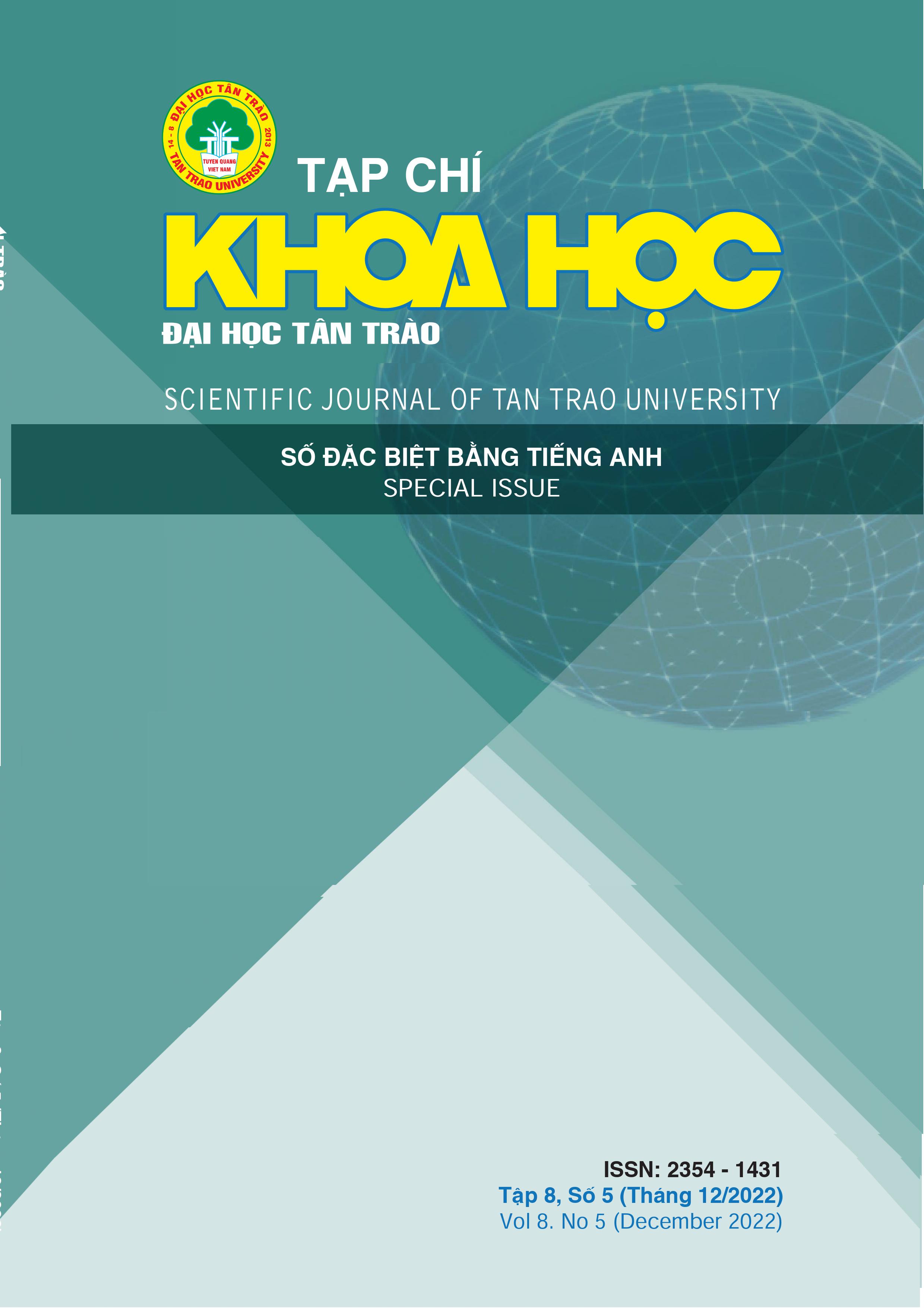PHÂN LẬP, TUYỂN CHỌN VI SINH VẬT BẢN ĐỊA PHÂN GIẢI XENLULO CAO ĐỂ SẢN XUẤT CHẾ PHẨM VI SINH VẬT XỬ LÝ BÃ THẢI CÂY GAI TẠI THANH HÓA
DOI:
https://doi.org/10.51453/2354-1431/2022/876Từ khóa:
Cây gai dầu Sự cô lập Sàng lọc Phân hủy cellulose Vi sinh vậtTóm tắt
Bã thải cây Gai cho đến giờ vẫn chưa tìm ra một phương pháp xử lý tối ưu, vì vậy, trong bài báo này, chúng tôi đã phân lập và tuyển chọn vi sinh vật bản địa phân giải xenlulo cao để có thể xử lý hiệu quả hơn. Nghiên cứu tiến hành phân lập trên môi trường GauzeI và Hans sau đó xác định hoạt tính CMC-aza, hoạt tính của vi sinh vật để tuyển chọn. Tiếp theo, xác định tên loài của các chủng được tuyển chọn bằng phương pháp tách DNA tổng số, PCR và Sequence. Kết quả cho thấy, đã chọn được 02 chủng vi khuẩn và 06 chủng xạ khuẩn từ 32 isolates để tiến hành các nghiên cứu tiếp theo. Các chủng này đã được xác định các điều kiện nuôi cấy phù hợp cho sinh trưởng, phát triển. Đánh giá hoạt tính sinh học của vi sinh vật dựa trên kết quả hoạt tính CMC-aza và tỷ lệ giảm khối lượng của mẫu thí nghiệm so với mẫu đối chứng, Kết quả đã chọn được TG2.1 và CM4.1 là Bacillus subtilis, PU1.1 là Streptomyces lilaceus, PU1.2
Kết quả phân loại TG2.1 và CM4.1 là Bacillus subtilis, PU1.1 là Streptomyces lilaceus, PU1.2 là Streptomyces misionensis và các chủng vi sinh vật tuyển chọn trên thuộc nhóm rủi ro cấp độ 1 (Nhóm an toàn). Vì vậy, có thể sử dụng các chủng này cho các thí nghiệm tiếp theo trong nghiên cứu sản xuất chế phẩm sinh học xử lý bã thải cây Gai tại Thanh Hóa
Tải xuống
Tài liệu tham khảo
REFERENCES
1]. B. C. Behera, S. Parida, S. K. Dutta, and H. Thatoi, “Isolation and Identification of Cellulose Degrading Bacteria from Mangrove Soil of Mahanadi River Delta and Their Cellulase Production Ability,” American Journal of Microbiological Research, vol. 2, pp. 41–46, 2014.
[2]. S. Flimban, SE. Oh, J. H. Joo, and K. A. Hussein, “Characterization and Identification of Cellulose-degrading Bacteria Isolated from a Microbial Fuel Cell Reactor,” Biotechnology and Bioprocess Engineering, vol. 24, pp. 622–631, 2019.
[3]. FNCA Biofertilizer Project Group, “Biofertilizer Manual,” 2006.
[4]. J. G. Holt, Bergey’s Manual of Determinative Bacteriology, 9th ed. Williams & Wilkins., 1994
[5]. T. T. N. Nguyen, Q. N. Pham, X. P. Le, Q. T. Pham, and M. C. Nguyen, "Isolating And Screening Micro-Organisms Highly Disolveable Xenlulo And Compatible With Eroded Soils, Charactering Their Physiologies/Biology To Produce Bio-Fertilizer For Forest Trees," Vietnam Journal of Forest Science, vol. 2, 2015.
[6]. J. Sambrook and D. W. Russell, Molecular cloning: A laboratory manual, 2nd ed., vol. 3. Cold Spring Harbor Laboratory Press, 2001
[7]. A.Singh and K. Hayashi, “Microbial cellulases: protein architecture, molecular properties, and biosynthesis,” Advances in Applied Microbiology, vol. 40, pp. 1–44, 1995.
[8]. J. T. Staley, M. P. Bryant, N. Pfennig, and J. G. Holt, Bergey’s Manual® of Systematic Bacteriology, 1st ed., vol. 3. Williams & Wilkins, 1989.
[9]. T. A. T. Tran, T. N. S. Tran, N. N. Nguyen, and H. M. Luu, "Influence of composted rice straw treated by Trichoderma sp, fungi on rice yield, rice soil fertility and economic effectiveness in summer-autumn 2010 in the Mekong Delta," Science and Technology Journal of Agriculture and Rural Development, pp. 37–44, 2011.
[10]. TCVN 12104:2018: Cellulose microorganism - Determination of cellulase activity.
[11]. V. P. Q. Vo and N. D. Cao, “Isolation and identification of cellulolytic bacteria,” Can Tho University Journal of Science, vol. 18a, pp. 177–184, 2011.
[12]. S. A. Waksman, The actinomycetes, vol. 2. Williams & Wilkins, 1961.
[13]. N.W. Schaad, J. B. Jones, and W. Chun (2002). Laboratory guide for identification plant pathogenic bacteria. Third Edition. The American Phytopathological Society.
[14]. G. Williams, “Staining reactions for the dẹlection of humiccl,” FEMS Microbiology Letters, vol. 20, pp. 253–258, 1983.
Tải xuống
Đã Xuất bản
Cách trích dẫn
Số
Chuyên mục
Giấy phép

Tác phẩm này được cấp phép theo Giấy phép Quốc tế Creative Commons Attribution-ShareAlike 4.0 .
Bài báo được xuất bản ở Tạp chí Khoa học Đại học Tân Trào được cấp phép theo giấy phép Ghi công - Chia sẻ tương tự 4.0 Quốc tế (CC BY-SA). Theo đó, các tác giả khác có thể sao chép, chuyển đổi hay phân phối lại các bài báo này với mục đích hợp pháp trên mọi phương tiện, với điều kiện họ trích dẫn tác giả, Tạp chí Khoa học Đại học Tân Trào và đường link đến bản quyền; nêu rõ các thay đổi đã thực hiện và các nghiên cứu đăng lại được tiến hành theo cùng một bản quyền.
Bản quyền bài báo thuộc về các tác giả, không hạn chế số lượng. Tạp chí Khoa học Tân Trào được cấp giấy phép không độc quyền để xuất bản bài báo với tư cách nhà xuất bản nguồn, kèm theo quyền thương mại để in các bài báo cung cấp cho các thư viện và cá nhân.
Mặc dù các điều khoản của giấy phép CC BY-SA không dành cho các tác giả (với tư cách là người giữ bản quyền của bài báo, họ không bị hạn chế về quyền hạn), khi gửi bài tới Tạp chí Khoa học Đại học Tân Trào, tác giả cần đáp ứng quyền của độc giả, và cần cấp quyền cho bên thứ 3 sử dụng bài báo của họ trong phạm vi của giấy phép.


